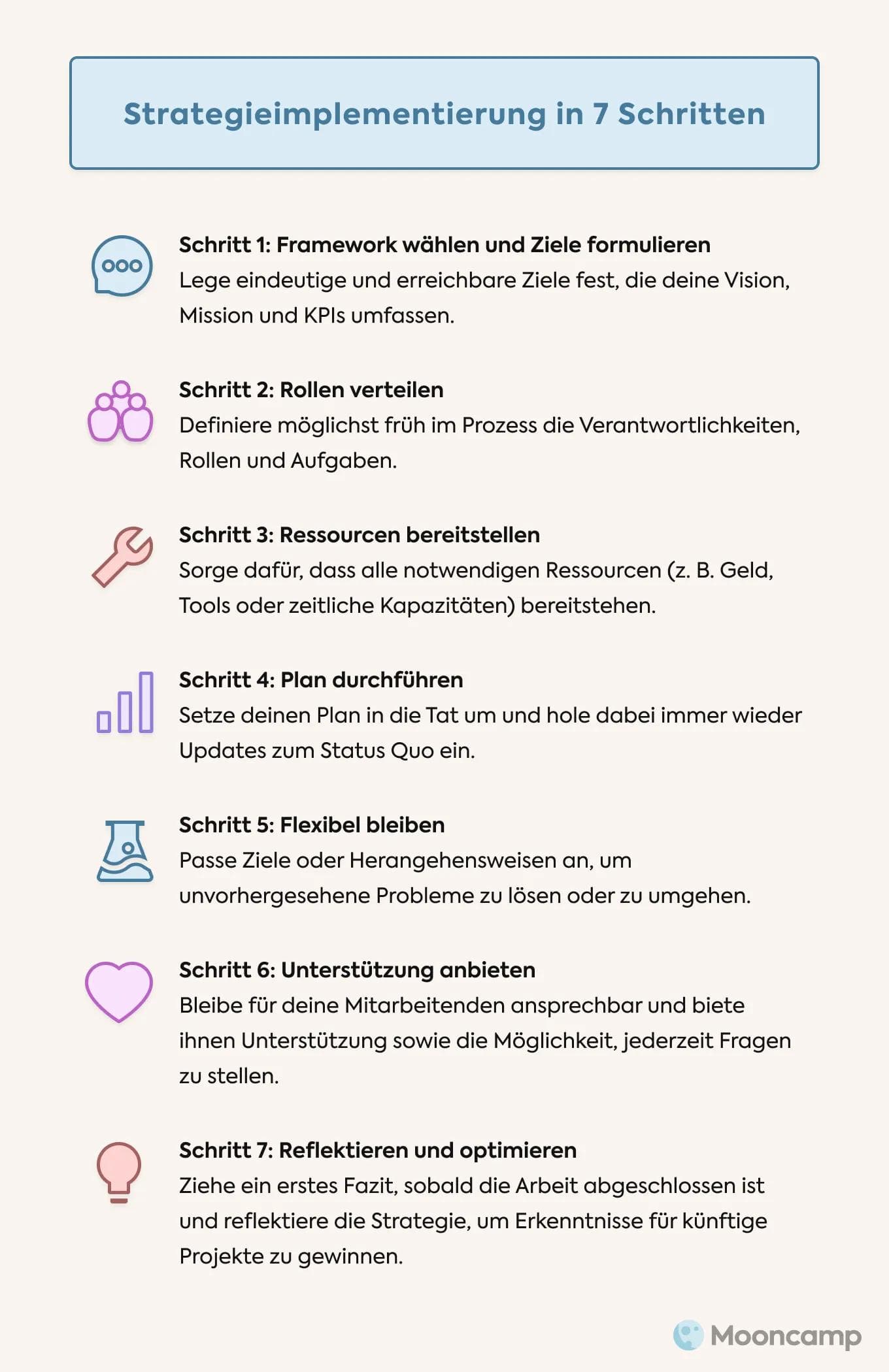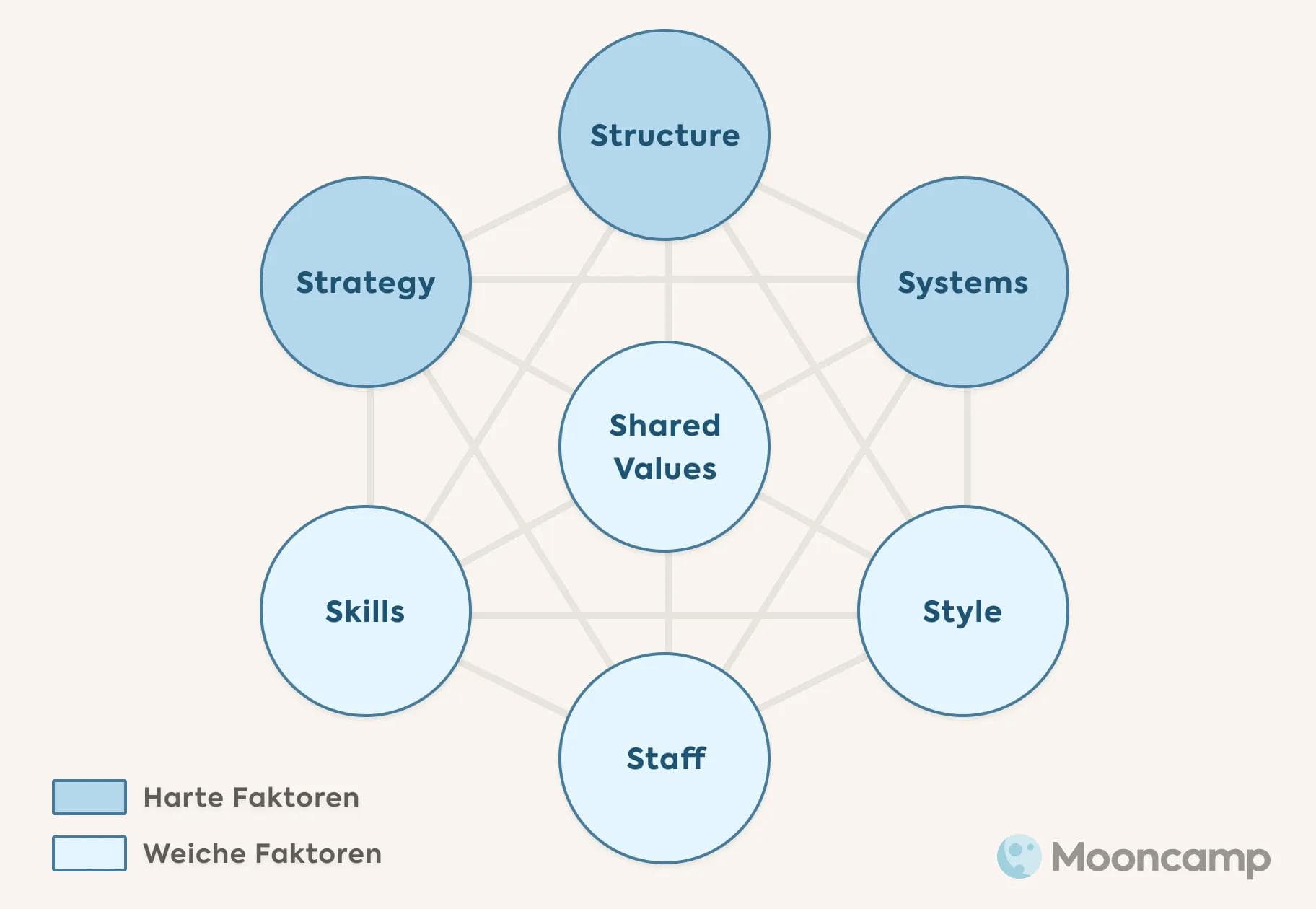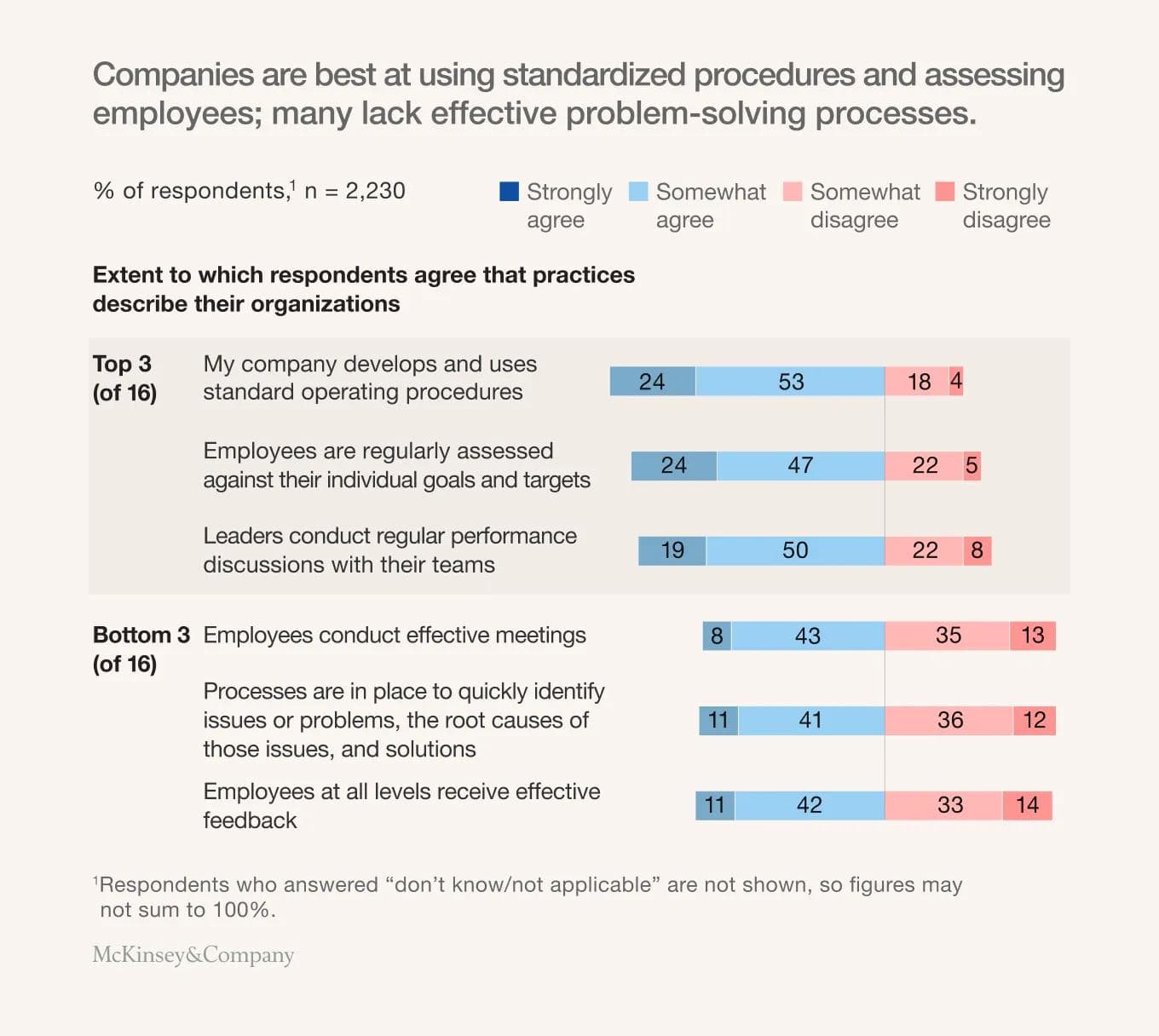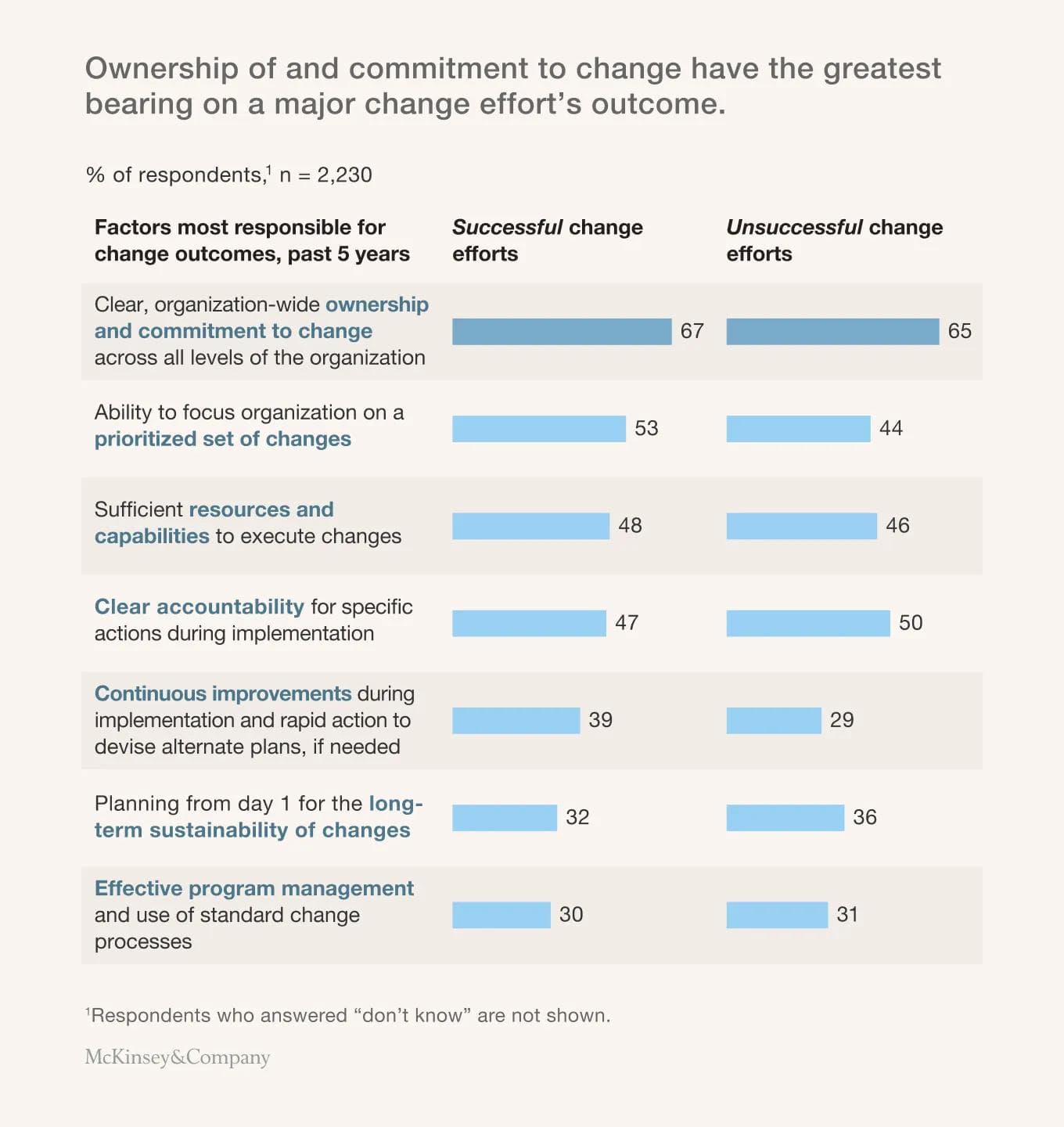Was ist Strategieumsetzung? Der Prozess in 7 Schritten

Egal ob es sich um einen neuen Marketingplan handelt oder um eine komplette Unternehmensstrategie – der Planung bei der Strategieumsetzung auch Taten folgen zu lassen, stellt Unternehmen immer wieder vor große Herausforderungen.
Worum es bei der Strategieumsetzung genau geht, wie man Strategien erfolgreich implementiert und welche Fehler man besser vermeiden sollte, erklären wir in diesem Artikel.
Das erwartet dich:
- Was bedeutet Strategieumsetzung? Definition
- Wie setzt man eine Strategie um?
- So geht's – Strategieimplementierung in 7 Schritten
- Probleme bei der Strategieumsetzung: 6 häufige Fehler und wie man sie vermeidet
- Was ist der Schlüssel zum Umsetzungserfolg? Modelle und Studienergebnisse
- Fazit: Umsetzung von Anfang an mitdenken
- Strategieumsetzung – FAQ
Was bedeutet Strategieumsetzung? Definition
Eigentlich ist der Begriff „Strategieumsetzung“ (auch: Strategieimplementierung) selbsterklärend. Gemeint ist damit der Prozess, den man durchläuft, wenn man einen strategischen Plan in die Tat umsetzt, um bestimmte Ziele zu erreichen. In anderen Worten: Strategieumsetzung ist die Kunst, Dinge zu erledigen.
Strategieumsetzung als Teil des strategischen Managements
Die Umsetzung bzw. Implementierung ist außerdem ein Teilschritt im ganzheitlichen strategischen Managementprozess. Dieser umfasst konkret fünf Phasen:
- 1️⃣ Ziele festlegen,
- 2️⃣ die aktuelle Situation analysieren,
- 3️⃣ eine Strategie gestalten,
- 4️⃣ die Strategie umsetzen und
- 5️⃣ Fortschritte bewerten.
Die Strategieumsetzung, der vierte Schritt, nimmt dabei am meisten Zeit in Anspruch.
Wie setzt man eine Strategie um?
Eine gut durchdachte Unternehmensstrategie ist zwar die Basis für eine erfolgreiche Strategieumsetzung, sorgt aber allein noch nicht dafür, dass wirklich alles glattgeht. Dafür bedarf es noch etwas mehr und zwar konkret:
- 🧑 Personen: Nur das Top-Management allein kann eine Strategie nicht umsetzen. Es braucht ein Team, das den Plan versteht und all die erforderlichen Fähigkeiten mitbringt, um diesen erfolgreich in die Tat umzusetzen.
- ⏳ Ressourcen: Es ist wichtig, dass Ressourcen, egal ob finanzieller (z. B. Kosten für ein Projekt) oder nicht-finanzieller Art (z. B. Arbeitszeit), effektiv verteilt und bereitgestellt werden.
- 📋 Organisation: Alle im Unternehmen sollten ihre Rollen im Umsetzungsprozess kennen. Es muss klar festgelegt und kommuniziert sein, wer die Führung übernimmt und Ansprechpartner für Fragen ist.
- ⚙️ Systeme: Die Implementierung sollte mit sinnvoll ausgewählten Management-Tools, Technologien und Systemen unterstützt werden.
- 🏆 Kultur: Eine Unternehmenskultur, in der die Mitarbeiterinnen und Mitarbeiter jederzeit alle nötigen Informationen bekommen sowie miteinbezogen werden, mildert den Stress, den die Einführung neuer Strategien für einzelne Teams bedeuten kann.
So geht's – Strategieimplementierung in 7 Schritten
Ohne einen klaren Plan ist der Sprung von der Strategieentwicklung zur Strategieumsetzung praktisch zum Scheitern verurteilt. Zusätzlich braucht es die nötigen Kapazitäten, Ressourcen und Unterstützung durch die Belegschaft.
Welche sieben Schritte ein Team oder Unternehmen gehen muss, um eine Strategie erfolgreich umzusetzen und ein festgelegtes Ziel zu erreichen, haben wir hier zusammengefasst.

1. Framework wählen und Ziele formulieren
Die zwei wichtigsten Komponenten erfolgreicher Strategieumsetzung sind klar formulierte Ziele und ein Verfahren, das dem Team hilft, diese zu erreichen. Die Ziele sollten dabei sowohl eindeutig als auch erreichbar sein und die Vision, Mission und KPIs des Unternehmens umfassen. Je klarer die Ziele formuliert sind, umso einfacher wird es, darauf hinzuarbeiten.
💡 Tipp: Ziele sind immer dann klar und erreichbar formuliert, wenn sie SMART sind. In unserem Blogbeitrag zur SMART-Methode erfährst du mehr darüber.
Ein Management-Framework wie Objectives und Key Results (OKR), Balanced Scorecard (BSC) oder Management by Objectives (MBO) kann helfen, ein klareres Bild der Strategie zu zeichnen und diese einfach und verständlich auf den Punkt zu bringen. Außerdem helfen Balanced Scorecard, OKRs & Co. dabei, die Umsetzung zu steuern, Aktivitäten zu koordinieren und zwischendurch zu kontrollieren, ob man sich noch auf dem richtigen Weg befindet.
2. Rollen verteilen
Um eine Strategie effektiv und effizient umzusetzen, braucht es klare Rollen und Verantwortlichkeiten. Jeder und jede im Team muss wissen, was er oder sie zu tun hat, wofür er oder sie zuständig ist und wer mit wem woran arbeitet. Außerdem sollte definiert werden, wer die Führung übernimmt und welche Deadlines einzuhalten sind. All das sollte möglichst früh geklärt werden, damit kein Aufgabenbereich übersehen wird.
💡 Tipp: Es kann hilfreich sein, ein extra Meeting abzuhalten, in dem man alle Rollen einmal durchgeht und offene Fragen klärt. Das sorgt für Transparenz und holt alle Teammitglieder ins Boot.
3. Ressourcen bereitstellen
Sind alle Rollen verteilt, heißt es: Ressourcen bereitstellen, die für die Strategieumsetzung notwendig sind – beispielsweise finanzielle Mittel, Tools oder zeitliche Kapazitäten. Sich einen Überblick zu verschaffen (und diesen auch zu behalten) ist dabei nicht immer einfach. Es hilft aber,
- das Projektende von Anfang an im Blick zu haben,
- einen klaren Projektumfang zu definieren,
- verfügbare Ressourcen im Team zu ermitteln und aufzulisten,
- den Plan für den Umsetzungsprozess mit allen Beteiligten zu teilen und Meinungen einzuholen.
4. Plan durchführen
Die Ziele stehen fest, alle Beteiligten wissen, was sie zu tun haben und die Ressourcenplanung steht ebenfalls? Dann wird es Zeit für den eigentlichen Umsetzungsteil. Während das Team daran arbeitet, die festgelegten Ziele zu erreichen, kann es sinnvoll sein, an bestimmten Meilensteinen im Prozess Updates einzuholen und Zwischenberichte zu erstellen – beispielsweise direkt nach Beginn, in der Mitte oder in der Endphase des Prozesses. Aber auch Herausforderungen, die gemeistert wurden oder Fehler, die passiert sind, eignen sich gut, um Fortschritte sichtbar zu machen.
5. Flexibel bleiben
Ist der Implementierungsprozess erst einmal gestartet, werden unweigerlich auch Hindernisse und unvorhergesehene Probleme auftauchen. Dann heißt es: flexibel auf Veränderungen reagieren und Ziele oder Herangehensweisen anpassen, um Probleme zu lösen oder zu umgehen.
💡 Tipp: Mehr dazu, was genau agiles Arbeiten ausmacht und welche agilen Methoden dir dabei helfen können, Herausforderungen zu meistern und flexibel auf Änderungen im Plan zu reagieren, findest du auf unserem Blog.
6. Unterstützung anbieten
Während des gesamten Umsetzungsprozesses gilt: Sobald die Rollen verteilt sind, sollten Führungskräfte darauf vertrauen, dass alle ihren Job selbstständig erledigen und auf die gemeinsamen Ziele hinarbeiten. Micromanagement ist fehl am Platz, bremst den Strategieprozess und sorgt schlimmstenfalls dafür, dass die Motivation verlorengeht.
Regelmäßiges Feedback, Unterstützung bei Problemen und die Möglichkeit, jederzeit Fragen zu stellen, wirken dagegen ermutigend und motivierend. Führungskräfte sollten daher bei der Strategieumsetzung eher eine coachende Rolle einnehmen, das „Große Ganze“ im Blick behalten und ihren Mitarbeiterinnen und Mitarbeitern mit Rat und Tat zur Seite stehen.
7. Reflektieren und optimieren
Die Implementierung einer Strategie ist ein langwieriger Prozess. Deshalb sollte man Punkte definieren, die markieren, wann der erste Umsetzungsprozess abgeschlossen ist und alle Aufgaben erledigt oder soweit angeschoben und auf den Weg gebracht sind, dass sich ein Fazit ziehen lässt.
Ist einer dieser Punkte erreicht, wird es Zeit für eine Nachbesprechung bzw. Retrospektive, in der Erfolge (und Misserfolge) im Implementierungsprozess besprochen, reflektiert und evaluiert werden. Die Ergebnisse werden festgehalten und sind die Basis für künftige Strategieprojekte. So lassen sich Fehler ausbügeln und es wird eine kontinuierliche Verbesserung angestoßen.
Probleme bei der Strategieumsetzung: 6 häufige Fehler und wie man sie vermeidet
Apropos Fehler: Kein großes Projekt läuft komplett ohne Stolperfallen und Hindernisse. Dass Fehler passieren ist normal – und lehrreich. Damit du trotzdem bestmöglich vorbereitet bist, haben wir hier sechs der häufigsten Fehler zusammengefasst, inklusive nützlicher Tipps, wie du sie bei deinem nächsten Projekt vermeidest.
1. Der Plan ist zu umfangreich oder unsinnig.
Werden Ziele zu komplex, zu ungenau oder zu ambitioniert gesetzt oder ist die strategische Planung schlicht zu umfangreich und undurchsichtig, kann das der Implementierung im Weg stehen.
✅ Die Lösung: Ein Management-Framework, das einem bei der Zielformulierung hilft und Regeln vorgibt, bringt Klarheit, Struktur und Fokus – und das bereits in der Planungsphase. OKRs werden dabei immer mehr zum „neuen Standard“, aber auch die SMART-Methode kann bei der Formulierung von erreichbaren, relevanten Zielen nützlich sein.
2. Der Plan wird zu strikt eingehalten.
Kein noch so guter Plan überlebt den Realitätscheck ohne Anpassungen. Es ist schlicht nicht möglich, jede Eventualität vorauszusehen. Wird dennoch strikt daran festgehalten, ist die Implementierung zum Scheitern verurteilt.
✅ Die Lösung: Führungskräfte und Mitarbeitende sollten im Kopf offen bleiben, sich an die Gegebenheiten anpassen, unerwartete Hindernisse überwinden und Chancen ergreifen. Agil zu bleiben, kreative Lösungen für Probleme zu finden und Gelegenheiten, die Strategie zu optimieren, zu nutzen, ist das, was eine erfolgreiche Strategieimplementierung ausmacht und ein Unternehmen von der Konkurrenz abhebt.
3. Es wird nicht klar genug kommuniziert.
Informationen werden nicht transparent genug weitergegeben und Führungskräfte schaffen es nicht, den strategischen Plan leicht verständlich aufzubereiten – obwohl sie ihn scheinbar ununterbrochen auf verschiedenen Kanälen kommunizieren. Dadurch entsteht schnell ein Gefühl der Hilflosigkeit und Überforderung im Team.
✅ Die Lösung: Wenn es darum geht, Strategien zu kommunizieren, kommt es nicht allein auf die Frequenz an, sondern vielmehr darauf, wie Informationen dargestellt und vermittelt werden. Je einfacher, desto besser kommt die Botschaft bei den Mitarbeitenden an. Diskussionen, Teammeetings und Messaging-Tools sind außerdem weit effektiver für die Kommunikation als einseitige Kanäle wie Newsletter, E-Mails & Co.
4. Die Verantwortlichkeiten sind nicht eindeutig festgelegt.
Das Team weiß nicht genau, worum es geht, wie es seine Aufgaben erfüllen und die strategischen Vorgaben umsetzen soll. Die Implementierung stockt dadurch, noch bevor sie richtig begonnen hat.
✅ Die Lösung: Klar verteilte Verantwortlichkeiten und Aufgaben beugen Missverständnissen vor und geben den Mitarbeitenden das Gefühl, dass sie einen wichtigen Teil zum Gesamtergebnis beitragen. Wichtig dabei ist, dass jeder und jede eine gewisse Verantwortung erhält und alle Ressourcen verfügbar hat, die nötig sind, um die zugeteilten Aufgaben zu erledigen.
5. Die Ausrichtung fehlt.
Selbst wenn alle Ziele sinnvoll gesetzt wurden und die Strategie passt, kann es passieren, dass die Implementierung ins Stocken gerät, weil die Ausrichtung (bzw. das Alignment) fehlt. Das führt zu Konflikten in der Zusammenarbeit, fehlenden Prioritäten und die strategischen Ziele geraten in Vergessenheit.
✅ Die Lösung: Es sollte klar aufgeteilt sein, wer wann an welchem strategischen Ziel arbeitet. Außerdem ist es hilfreich, den Mitarbeiterinnen und Mitarbeitern die Strategie immer wieder vor Augen zu führen und daran zu erinnern, worauf sie hinarbeiten. Übergeordnete Strategien sollten in leicht verständliche Einzelziele für alle Unternehmensbereiche übersetzt werden, damit alle sie verstehen und wissen, was Priorität hat.

6. Der Fortschritt kann nicht richtig verfolgt werden.
Viele Unternehmen versäumen es, die richtigen Kennzahlen festzulegen oder nutzen unübersichtliche Excel-Tabellen, um ihre Fortschritte im Implementierungsprozess zu verfolgen. Das mag für kleine Teams funktionieren, wird aber schnell unübersichtlich.
✅ Die Lösung: Besser ist es, Tools zu verwenden, die einen beim Tracking unterstützen. So wird das Monitoring transparenter und alle Informationen werden übersichtlich an einem zentralen Ort gesammelt und ausgewertet. Das erleichtert die gemeinsame Ausrichtung, die Kommunikation, die Zusammenarbeit und macht das gesamte Unterfangen effizienter.
Was ist der Schlüssel zum Umsetzungserfolg? Modelle und Studienergebnisse
Natürlich gibt es auch zahlreiche Methoden, Modelle und Tools, die die Strategieumsetzung leichter machen und hilfreiche Guidelines bieten. Zwei der bekanntesten Modelle sind das 7-S-Modell von McKinsey und die drei K der Strategieumsetzung von Scott Edinger.
Strategien umsetzen mit dem 7-S-Modell von McKinsey
Die Strategie- und Unternehmensberatung McKinsey hat ein Modell mit sieben Faktoren entwickelt, die für eine erfolgreiche Strategieumsetzung nötig sind.
Diese sind unterteilt in „harte“ und „weiche“ Elemente, wobei die harten Elemente relativ leicht identifiziert und beeinflusst werden können, während die weichen Elemente weniger handfest und schwerer zu gestalten sind.
Die harten Elemente sind:
- Strategy: Die Strategie, die ein Unternehmen verfolgt, um sich gegenüber Mitbewerbern am Markt einen Vorteil zu sichern
- Structure: Die Hierarchie und Organisationsstruktur eines Unternehmens
- Systems: Sämtliche Prozesse, Tools und Aktivitäten im Tagesgeschäft
Zu den weichen Elementen gehören:
- Style: Die Unternehmenskultur als Basis für die Zusammenarbeit
- Staff: Sämtliche Mitarbeitende im Unternehmen
- Skills: Die Fähigkeiten und besonderen Kompetenzen des Teams
- Shared Values: Die gemeinsam geteilten Grundwerte im Unternehmen

Insgesamt sind im Modell alle Elemente miteinander verbunden. Ändert sich ein Element, hat das immer auch Auswirkungen auf die anderen Elemente. Die gemeinsamen Werte stehen dabei im Zentrum. Idealerweise stehen alle Elemente miteinander im Einklang.
Die drei K der Strategieumsetzung
Drei Schritte, die man für eine erfolgreiche Implementierung durchlaufen sollte, hat Unternehmensberater und Autor Scott Edinger zusammengefasst – und zwar in Form der drei K der Strategieumsetzung: Klarheit, Kommunikation und Kaskade (engl.: 3 C – Clarity, Communication, Cascade).
Schauen wir uns einmal genauer an, was sich hinter den drei Ks verbirgt.
- Klarheit: Die Strategie sollte so formuliert sein, dass sie nicht nur die Führungskräfte, sondern auch alle Mitarbeitenden verstehen.
- Kommunikation: Die Strategie sollte auf allen Ebenen des Unternehmens über verschiedene Medien (z. B. interne Blogs, Podcasts, Besprechungen, Diskussionen) kommuniziert werden. Es sollte klar werden, wie jeder Mitarbeiter und jede Mitarbeiterin individuell zur erfolgreichen Umsetzung der Strategie beitragen kann.
- Kaskade: Auch wenn die Strategie insgesamt schon kommuniziert ist, sollte man sicherstellen, dass sie wirklich überall, in allen Bereichen und bei allen Mitarbeitenden angekommen ist. In diesem Schritt sind Führungskräfte besonders gefragt: Sie müssen die Strategie verstanden haben, sie ihrem Team nahebringen (z. B. in Teambesprechungen oder Einzelcoachings) und auf den eigenen Bereich übertragen können.

Studie: Faktoren, die den Unterschied machen
So viel zur Theorie – doch wie sieht die Praxis aus? Eine Studie der Unternehmensberatung McKinsey zeigt deutlich, wie schwierig es ist, Strategien in die Tat umzusetzen: Weniger als die Hälfte der Befragten (insgesamt nahmen mehr als 2200 Führungskräfte aus 900 Unternehmen aller Branchen teil) gab an, dass sie mit den meisten oder all ihren Bemühungen zur Veränderung in den letzten fünf Jahren ihre ursprünglichen Ziele erreicht und nachhaltig etwas bewirkt haben.
Vor allem scheinen die meisten Unternehmen zu schwächeln, wenn es darum geht, effektive Besprechungen durchzuführen, Probleme zu erkennen und zu lösen sowie den Mitarbeitenden Feedback zu geben.

Bei den Unternehmen, die erfolgreich Strategien implementieren konnten, waren es die unternehmensweite Akzeptanz und das Engagement für den Wandel, klar festgelegte Prioritäten sowie ausreichende Ressourcen und Fähigkeiten, die am Ende den Erfolg der Umsetzung ausgemacht haben.
Fazit: Umsetzung von Anfang an mitdenken

Zusammengefasst lässt sich sagen: Eine Strategie umzusetzen, ist alles andere als einfach. Es ist ein komplexes Unterfangen, das Potenzial für zahlreiche Fehler bietet und Unternehmen immer wieder vor große Herausforderungen stellt.
Viele der häufigsten Probleme bei der Strategieimplementierung lassen sich allerdings relativ einfach lösen oder umgehen, wenn man von Anfang an auf ein strategisches Framework setzt, das einen auf dem gesamten Weg begleitet – und sowohl bei der Planung als auch bei der Umsetzung unterstützt.
Denn nur, wer bei der strategischen Planung bereits mit im Blick hat, ob eine Strategie sich später auch tatsächlich implementieren lässt, wird auf lange Sicht Erfolg damit haben.
Strategieumsetzung – FAQ
Was macht eine gute Strategie aus?
Eine gute Strategie zeichnet sich dadurch aus, dass sie sich auf das Wesentliche fokussiert und die übergeordnete Vision des Unternehmens in eindeutige, messbare und erreichbare Ziele übersetzt. Sie nimmt den Mitarbeitenden keine Entscheidungen ab, sondern schafft einen Rahmen, innerhalb dessen diese selbstbestimmt arbeiten können.
Was braucht es für eine erfolgreiche Strategieumsetzung?
Um Strategien erfolgreich umzusetzen, braucht es unter anderem ein Team, das den Plan versteht und die passenden Fähigkeiten mitbringt, ausreichend Ressourcen, eine gute Organisation, sinnvoll ausgewählte Tools und Systeme und eine offene Unternehmenskultur.
Warum ist Strategieumsetzung wichtig?
Wer eine Strategie entwickelt, ohne dabei darauf zu achten, ob diese sich auch umsetzen lässt, wird damit unweigerlich scheitern. Deshalb ist es essenziell, die Umsetzung bereits von Anfang an mitzudenken.
Wann ist eine Strategie erfolgreich umgesetzt?
Eine Strategie gilt dann als erfolgreich implementiert, wenn sie in den Köpfen aller Mitarbeitenden verankert ist, die ersten Aufgaben erledigt und soweit vorangetrieben wurden, dass der Grundstein für die weitere Entwicklung gelegt ist und die erste Implementierungsphase abgeschlossen ist.
